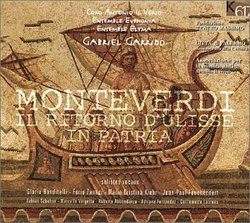| All Artists: Claudio Monteverdi, Gabriel Garrido, Ensemble Elyma, Gloria Banditelli, Furio Zanasi, Maria Cristina Kiehr, Jean-Paul Fouchécourt, Fabian Schofrin, Marcello Vargetto Roberto Abbondanza , Guillemette Laurens Adriana Fernandez Title: Monteverdi - Il rittorno d'Ulisse in patria / Garrido Members Wishing: 0 Total Copies: 0 Label: K617 Records France Original Release Date: 1/1/2000 Re-Release Date: 1/9/2001 Album Type: Import Genres: Alternative Rock, Classical Styles: Opera & Classical Vocal, Historical Periods, Baroque (c.1600-1750) Number of Discs: 3 SwapaCD Credits: 3 UPCs: 3383510000911, 713746022020 |
Search - Claudio Monteverdi, Gabriel Garrido, Ensemble Elyma :: Monteverdi - Il rittorno d'Ulisse in patria / Garrido
 | Claudio Monteverdi, Gabriel Garrido, Ensemble Elyma Monteverdi - Il rittorno d'Ulisse in patria / Garrido Genres: Alternative Rock, Classical
Claudio Monteverdi's Il Ritorno d'Ulisse ("The Return of Ulysses") is more difficult to bring off on record than the more famous L'Orfeo. Whereas the latter has a virtuoso centerpiece aria, memorable choruses, and a large... more » |
Larger Image |
CD Details
Synopsis
Amazon.com
Claudio Monteverdi's Il Ritorno d'Ulisse ("The Return of Ulysses") is more difficult to bring off on record than the more famous L'Orfeo. Whereas the latter has a virtuoso centerpiece aria, memorable choruses, and a large, colorful orchestra, Ulisse survives with only the characters' vocal parts notated over basso continuo (a bass line over which chordal instruments improvise an accompaniment); the choruses and the instrumental interludes indicated in the libretto are missing. Most conductors reviving Ulisse today orchestrate the score--René Jacobs, for example, not only imported sinfonias from other works, but composed extensive parts for violins, cornets, etc., to accompany the singers. Gabriel Garrido has added instrumental pieces and adapted madrigals for the choruses to accommodate the full libretto, but he leaves the accompanying of the soloists to his 10 splendid continuo players. Those soloists are outstanding, with pleasing voices, excellent diction, and solid Monteverdian style. Most crucially, Garrido and his cast show a unerring sense of when to speed through recitative as if it were conversation, when to linger over the notes, and when to employ a solid rhythmic pulse. Jacobs's version may have more theatrical excitement, but Garrido makes more beautiful music--and, ultimately, more convincing drama. --Matthew Westphal

 Track Listings (10) - Disc #1
Track Listings (10) - Disc #1